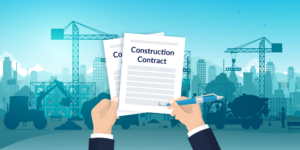Getting the construction contract right before work starts on a project is one of the best ways to prevent disputes down the road. In the construction industry, many jobs get started on handshake deals or oral agreements. Others may use an unnecessarily complex contract, or a boilerplate contract that fails to cover the full scope of the project.
Oftentimes, contractors don’t reach out to a construction lawyer until legal issues have already come up. The lawyer is then left to work backward to identify the problem and how best to proceed. But that is changing, with the rising prevalence of legal plans and preventative legal counsel.
In this blog, we’ll dive into how lawyers can help their clients prevent payment disputes by drafting effective construction contracts. This piece has been adapted from Levelset’s free CLE course on “Four Vital Documents For Preventing Construction Disputes.”
The contract should only be as complex as the the job is
Complexity in the contract begets complexity on the job. The more words, clauses and sections in your contract, the more likely that your client, their subs, customers and various parties all along the chain may not understand something in the contract. When someone doesn’t understand something in the contract, this can slow down the process of starting work at best, and at worst can lead to disputes.
Don’t rely on form contracts. Especially nowadays, it’s easy to find any number of construction contract templates on the internet. However, each contract should be specific to the job it is covering. It should be as simple to understand as possible and not contain anything superfluous.
It may seem obvious, but simplifying your client’s contracts can go a long way toward heading off disputes: Are preliminary notices required in the state your client is doing business in? If not, then you don’t need anything in the contract about it. Try to avoid any situation where certain clauses or parts of the contract could get thrown out in court because they don’t comply with state-specific regulations.
The longer and more complicated a contract seems, the more opportunities there are for issues to come up that can slow the project down for everyone.
Make sure all parties are on the same page
As a lawyer, you’re obligated to promote the best interests of your client. However, in the case of the contract, the best thing you can do for your client is make sure all parties are aligned on the scope and nature of the work to be performed.
If you’re expecting specific materials or equipment to be necessary for the job, that should be made explicit in the contract. Ambiguity should be avoided, and nothing should be left to chance as much as possible.
Less-experienced lawyers may think they’re doing their client a favor by trying to sneak advantageous clauses into the contract without other parties noticing. But doing so usually creates more trouble than anything else — creating distrust, payment issues, and the potential for litigation.
Drafting and reviewing the contract is a perfect opportunity to make sure all parties understand and agree upon the work and expectations. If anyone has questions about why certain clauses are included, they should be discussed up front. When everyone is on the same page about who will do what, the work can flow much more smoothly.
Include change order procedures in the contract
As most anyone in the construction industry can attest, jobs can go awry even with the best laid foundations. That’s why your contract should ideally account for change orders, and the procedure by which they will be employed.
It’s not uncommon for contractors to sometimes bid low in order to secure a project, then attempt to make up the difference in change orders. But this kind of tactic is a direct route to a potential dispute. Change orders should be used when needed and not in an attempt to cover work that should have been contemplated by the contract to begin with.
A good rule of thumb to share with your construction clients: any attempt to materially change what is expected on the job after the contract has been signed is an easy way to wind up in a payment dispute.
Instead, account for the work to be completed as best you can. And include in the contract the procedure for changes should they become necessary once the work has begun. This language should include who needs to be notified, when and how, various parameters for changes to go into effect, and any other pertinent info.
That way, if something unexpected happens on the worksite, all parties are already in agreement on how the matter will be handled.
Use the construction contract to set your clients up for success
In construction, laying the foundation is one of the most important steps on a job and will impact the entire project. The contract is your legal foundation, and it should be as solid as you can make it. Even if something unexpected happens during the job, your clients will be better equipped and protected from small speed bumps becoming a more substantial or costly issue.
If you found this information helpful, check out the rest of the CLE from our lawyers. Levelset hosts monthly free CLEs for lawyers all around the country. We have the largest network of construction lawyers around the country, and thousands of contractors visit each month to get answers and connect with lawyers.

